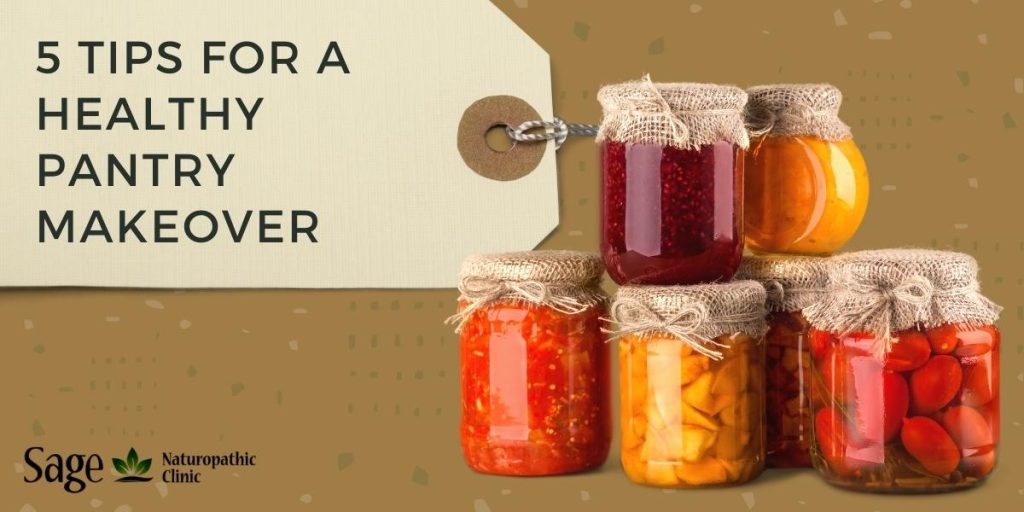
March is the month when we welcome spring (at least in the calendar) and with it we start planning a spring cleaning in the house.
March is also nutrition month, reminding us to reassess our food choices and eating habits. In this article, I’d like to inspire you to “spring clean” your kitchen pantry: remove some of the unhealthy foods lurking in it and replace them with nutrient-dense substitutes.
Here are some of my basic tips for the healthy pantry transformation:
- The two side dish staples in most household pantries are white wheat pasta and white rice. These are foods devoid of most nutrients present in the original grains, so my first suggestion is to replace them with their whole-grain versions. I also recommend stocking up on other gluten-containing and gluten-free grain foodsforadding variety toyour diet. Eating the same food on a daily basis (in this case wheat or rice) can lead to digestive problems and food intolerances.A simple way to avoid such issuesis to alternate betweenkamut, spelt, quinoa or chickpea pasta, whole quinoa or buckwheat and a few varieties of rice (jasmine, basmati, red rice, etc.).
- For preparing weeknight dinners, I like to stock up on various canned beans and lentils. These fibre-rich foods, which provide folate, iron, potassium, magnesium and also protein, can help us createnutritious meat-based or vegetarian meals in no time at all. They can be added to warm or cold salads, stews, soups or simple side dishes.I opt for brands whichuse BPA-free cans and I always make sure that I discard the water that beans/lentils are canned in, followed by a thorough rinse under running water before cooking. This simple prep step helps with reducing bloating and flatulence these foods may cause.
- Do you use various sauces and dressings in your cooking? Check out their list of ingredients! You will find preservatives, artificial flavourings, stabilizers and a relatively high amount of sugar in most of them. If you are serious about healthy changes, get rid of them! The healthier alternative to sauces and dressings are herbs and spices, which are loaded with minerals, antioxidants and other phytonutrients.You can simply sprinkle them in the food you are cooking or prepare a quick homemade marinade by combining them with oil, vinegar or lemon, honey or maple syrup, salt, fresh garlic, and so on.
- What type of oil do you have in your pantry? If it is a vegetable oil blend in a transparent plastic bottle, like canola or sunflower oil, I suggest against cooking with them. These oils are highly processed and often become rancid during production. There are a few staple oils I have in my pantry which I use based on their smoke points. Extra virgin olive oil I recommend for preparing salad dressings, dips or for low-heat cooking (e.g. sautéing) because of its lower smoke point. The mild-flavoured avocado oil has a higher smoke point, and is therefore suitable for frying or roasting. Both of these oils are kept in dark glass bottles which prevent their oxidization. I also keepvirgin coconut oil in my pantry, which is my preferred oil for baking or for stir-fry recipes in which the mild coconut flavour blends in.
- Lastly, what to keep in your pantry for healthy snacking? I always have some organic nut butter (almond, cashew or peanut) to be used as a dip for fruits or veggie sticks. Raw nuts and seeds, another blood-sugar-balancing, fibre-richoption, can be combined with some raisins or dried blueberries, cranberries, currants or other fruits. I also recommend keeping some popping corn on hand which, when popped and flavoured at home, can serve as ahealthysubstitute for the fatty and salty chips most of us like to munch on. In my pantry, you can also find unsweetened apple sauce for snacking which I often use in baking recipes too. If you like to stock up on snack bars, make sure you learn to read their labels so you can choose products with no artificial additives, low sugar, low simple carbohydrates and high levels ofimportant nutrients such as fibre, protein and healthy fats.
You may already have some of these foods on your pantry shelves, but if you don’t, it is time to swing into action. Even if you cannot follow all five of my pantry transformation tips right away, you can start with just one or two for now and slowly continue making further healthy food substitutions.
Lastly, let me share a grainfreedairyfree side dish recipe, Lentil Salad with Maple Roasted Squash, which can be served cold or warm. You can prepare it from some of the staple pantry foods mentioned in around 30 minutes. Enjoy!
By Marianna Duba,
Holistic Nutritionist